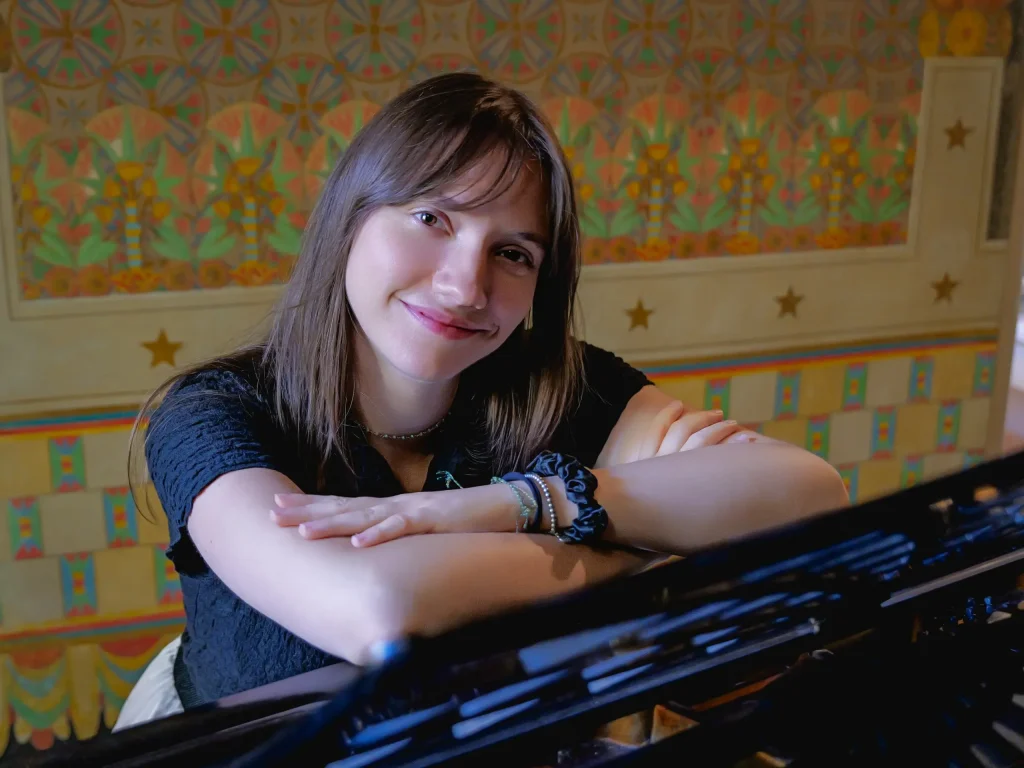Detroit, Michigan, August 27, 1937
Los Angeles, California, January 12, 2007

Alice McLeod Turiyasangitananda remains one of the most enigmatic and groundbreaking figures in 20th-century music. A pianist, organist, harpist, composer, and bandleader, her name is often linked to that of her husband, saxophonist John Coltrane. However, her career extends far beyond being the “wife of” and stands as a unique artistic journey in its own right.
From her early days in Detroit’s jazz scene to founding an ashram in California, her music is a metaphysical journey that blends jazz, gospel, Indian classical music, experimentation, deep spirituality, and a relentless pursuit of the divine.
Early years in Detroit and meeting John Coltrane
Born in Detroit in 1937, Alice was the fifth of six children in a musically rich household. From an early age, she displayed remarkable talent – starting piano at seven and studying both classical and jazz music. As a teenager, she played the organ at her local church and frequently participated in jam sessions, often accompanied by her stepbrother, bassist Ernest Farrow. By the 1950s and early 1960s, she was leading her own ensembles within Detroit’s vibrant jazz scene.
Over the years, she collaborated and performed with musicians such as Terry Pollard, Kenny Clarke, Kenny Burrell, Ornette Coleman, Pharoah Sanders, Charlie Haden, Roy Haynes, and Jack DeJohnette.
In the 1960s, Alice moved to Paris, where she married jazz singer Kenny Hagood and had a daughter, who later became a vocalist. After their marriage ended, she returned to the United States and joined vibraphonist Terry Gibbs’ band. It was during this time that she met John Coltrane, sparking a deep musical and personal connection. They married in 1965, and Alice replaced pianist McCoy Tyner in John’s quartet.
Their artistic collaboration resulted in six albums, in which Alice introduced an innovative keyboard approach, fully exploring the piano’s range and experimenting with modes and dissonances. These recordings include Expression (1967), Cosmic Music (1968, released posthumously), Om (1968, recorded in 1965), Selflessness Featuring My Favorite Things (1969, with recordings from 1965–66), and Stellar Regions (1995, a posthumous release recorded in 1967).
However, their union was tragically brief. In 1967, John Coltrane died of liver cancer, leaving Alice with their three young children, including Ravi Coltrane, who would later follow in his father’s footsteps to become an accomplished saxophonist.
The pain of her loss pushed Alice further into an intense spiritual quest that profoundly shaped her musical vision. On the one hand, she continued traveling through the musical portal she had opened with John; on the other, she brought to completion what could be described as “the spiritual (in art) of jazz” – borrowing the famous expression from painter Wassily Kandinsky.

A spiritual awakening and the search for a new sound
Even before John’s death, Alice had begun exploring meditation and Eastern philosophies, but it was in the 1970s that her spiritual transformation became central to her life. In 1970, she traveled to India, where she met Swami Satchidananda—known as the “Woodstock guru.” It was there that she received her spiritual name, Turiyasangitananda, meaning “the highest song of bliss of the transcendent Lord.”
Settling in California, she founded the Vedantic Center in 1972, a spiritual study center dedicated to Eastern religions. Later, in 1992, she became the first swamini (spiritual teacher) at the first Hindu temple in the San Fernando Valley. During this period, she wrote four religious texts and recorded several albums combining gospel, jazz, and Sanskrit chants. Initially, these recordings remained private, intended only for her disciples. However, after her passing, her family released them, revealing a previously unseen side of her artistry.
A musical legacy beyond jazz
Alice Coltrane refused to be confined by labels. Her music fused diverse influences—from the gospel of her childhood to the bebop she played with John, to the mystical melodies inspired by Indian classical music. As harpist and composer Brandee Younger, who frequently collaborates with Alice’s son Ravi, puts it:
“You can really hear all of her influences – it’s like she put them all in a bowl and stirred them together.”
In 2004, after years devoted primarily to spirituality, Alice returned to jazz to record her final album, Translinear Light, alongside her sons Ravi and Oran (who also became a saxophonist). It was her way of reconnecting with the music that had made her famous, as if to complete a cycle.
The multi-instrumentalist passed away in 2007 from respiratory failure, leaving behind a musical and spiritual legacy impossible to confine to a single genre. Her son Ravi once said:
“She was truly unique. She lived a life that I imagine very few people have experienced”.
An artist who transcended the boundaries of music, transforming it into a medium for the search for the infinite.
Some time ago, I came across an article discussing the thoughts of Kandinsky and philosopher Martin Heidegger, which contained a phrase that has stayed with me (though I don’t recall the author). It perfectly captures the transcendental essence of Alice Coltrane’s music: “Art is nothing more than the language of being in the service of the divine”.
Recommended Listening
From Translinear Light, I suggest listening to the title track, featuring:
- Alice Coltrane – composition & piano
- Ravi Coltrane – soprano saxophone & percussion
- Charlie Haden – bass
- Jack DeJohnette – drums
American music historian Ashley Kahn once quoted Alice Coltrane in an article: “Look at what ‘trance’ means. It means to transcend… it means to become transcendental! So, if we obtain a single transcendental path of light, it could lead to extraordinary dimensions of consciousness, revelation, spirituality, and spiritual power.”
Bibliography and Sources
Linda Dahl, Stormy Weather: The Music and Lives of a Century of Jazzwomen, Proscenium Publishers, 1984.
Ashley Kahn, Alice Coltrane: ‘Translinear Light’, 2004, www.npr.org

